Soul torture TCP, do you want to surrender?

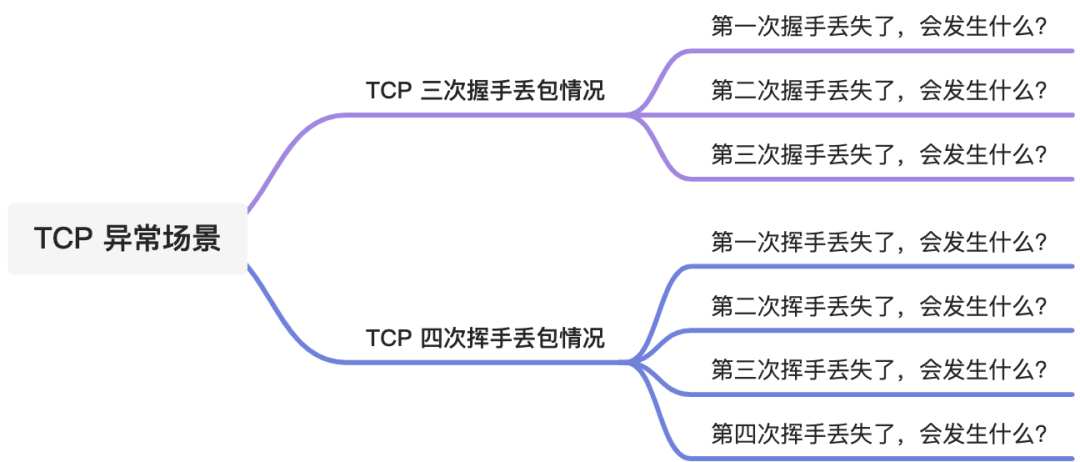
TCP three-way handshake packet loss
The first handshake is lost, what happens?
When the client wants to establish a TCP connection with the server, it first sends a SYN message, and then enters the SYN_SENT state.
After that, if the client fails to receive the SYN-ACK message from the server (the second handshake), it will trigger the "timeout retransmission" mechanism to retransmit the SYN message, and the retransmission of the SYN message will be The serial numbers are the same.
Different versions of the operating system may have different timeouts, some are 1 second, some are 3 seconds, this timeout is written in the kernel, if you want to change, you need to recompile the kernel, which is more troublesome.
When the client does not receive the SYN-ACK message from the server after 1 second, the client will resend the SYN message. How many times does it resend?
In Linux, the maximum number of retransmissions of the client's SYN message is controlled by the tcp_syn_retries kernel parameter. This parameter can be customized. The default value is generally 5.
# cat /proc/sys/net/ipv4/tcp_syn_retries
5- 1.
- 2.
Usually, the first time-out retransmission is after 1 second, the second time-out retransmission is after 2 seconds, the third time-out retransmission is after 4 seconds, and the fourth time-out retransmission is after 8 seconds. Five are after a timeout of 16 seconds of retransmission. That's right, each timeout is twice as long as the last.
After the fifth timeout retransmission, it will continue to wait for 32 seconds. If the server still does not respond with ACK, the client will no longer send SYN packets, and then disconnect the TCP connection.
So, the total time is 1+2+4+8+16+32=63 seconds, about 1 minute.
For example, if the value of the tcp_syn_retries parameter is 3, then when the client's SYN message has been lost in the network, the following process will occur:
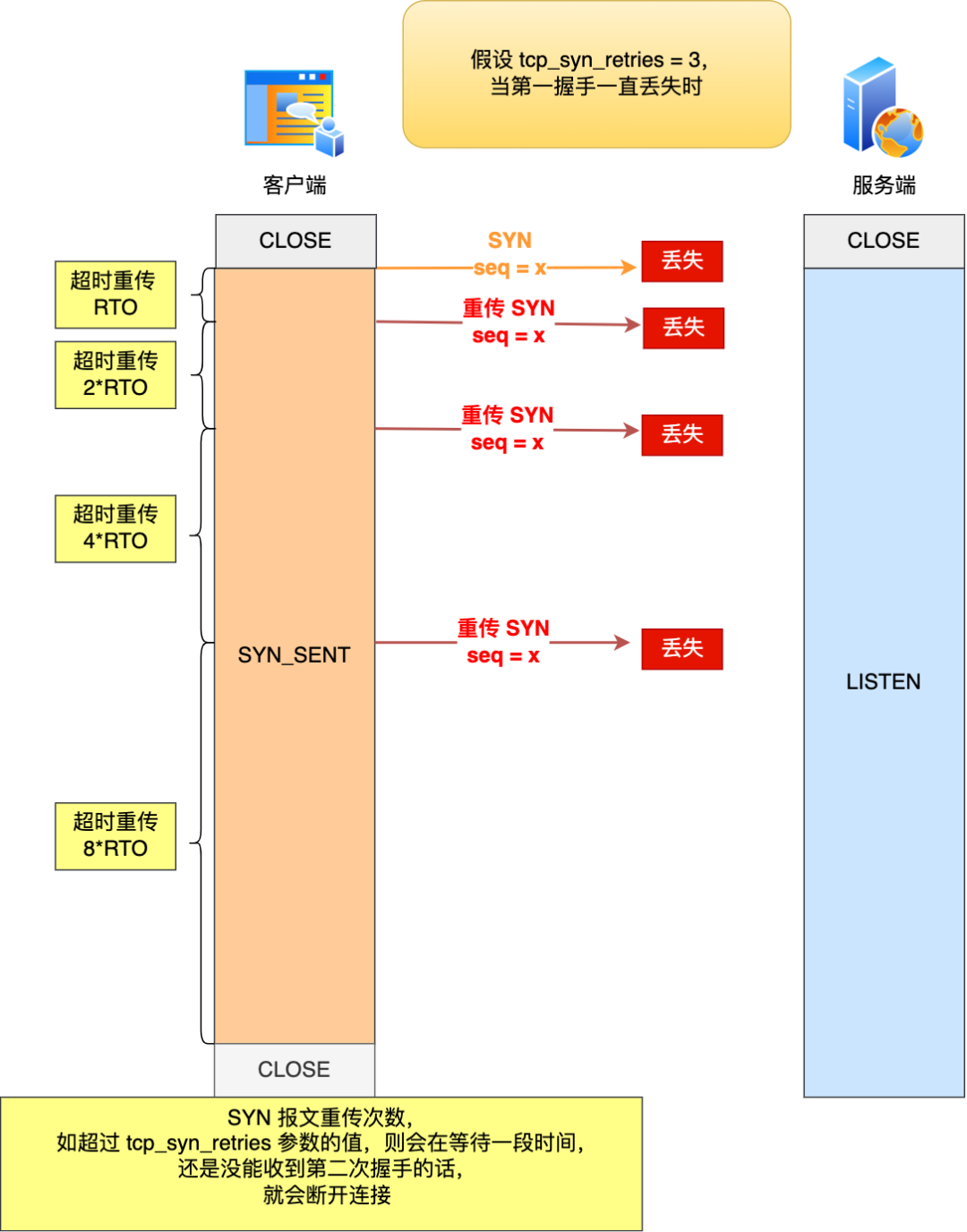
Specific process:
- When the client retransmits the SYN message 3 times after timeout, the maximum number of retransmissions has been reached because tcp_syn_retries is 3, so wait for a while (the time is twice the last timeout time), if the server still fails to receive the message The second handshake (SYN-ACK message), then the client will disconnect.
The second handshake is lost, what happens?
When the server receives the first handshake from the client, it will return a SYN-ACK message to the client. This is the second handshake, and the server will enter the SYN_RCVD state.
The SYN-ACK message of the second handshake actually has two purposes:
- The ACK in the second handshake is the confirmation message for the first handshake;
- The SYN in the second handshake is the message that the server initiates to establish a TCP connection;
So, if the second handshake is lost, something interesting will happen. What will happen specifically?
因为第二次握手报文里是包含对客户端的第一次握手的 ACK 确认报文,所以,如果客户端迟迟没有收到第二次握手,那么客户端就觉得可能自己的 SYN 报文(第一次握手)丢失了,于是客户端就会触发超时重传机制,重传 SYN 报文。
然后,因为第二次握手中包含服务端的 SYN 报文,所以当客户端收到后,需要给服务端发送 ACK 确认报文(第三次握手),服务端才会认为该 SYN 报文被客户端收到了。
那么,如果第二次握手丢失了,服务端就收不到第三次握手,于是服务端这边会触发超时重传机制,重传 SYN-ACK 报文。
在 Linux 下,SYN-ACK 报文的最大重传次数由 tcp_synack_retries内核参数决定,默认值是 5。
# cat /proc/sys/net/ipv4/tcp_synack_retries
5- 1.
- 2.
因此,当第二次握手丢失了,客户端和服务端都会重传:
- 客户端会重传 SYN 报文,也就是第一次握手,最大重传次数由tcp_syn_retries内核参数决定;
- 服务端会重传 SYN-ACK 报文,也就是第二次握手,最大重传次数由tcp_synack_retries 内核参数决定。
举个例子,假设 tcp_syn_retries 参数值为 1,tcp_synack_retries 参数值为 2,那么当第二次握手一直丢失时,发生的过程如下图:
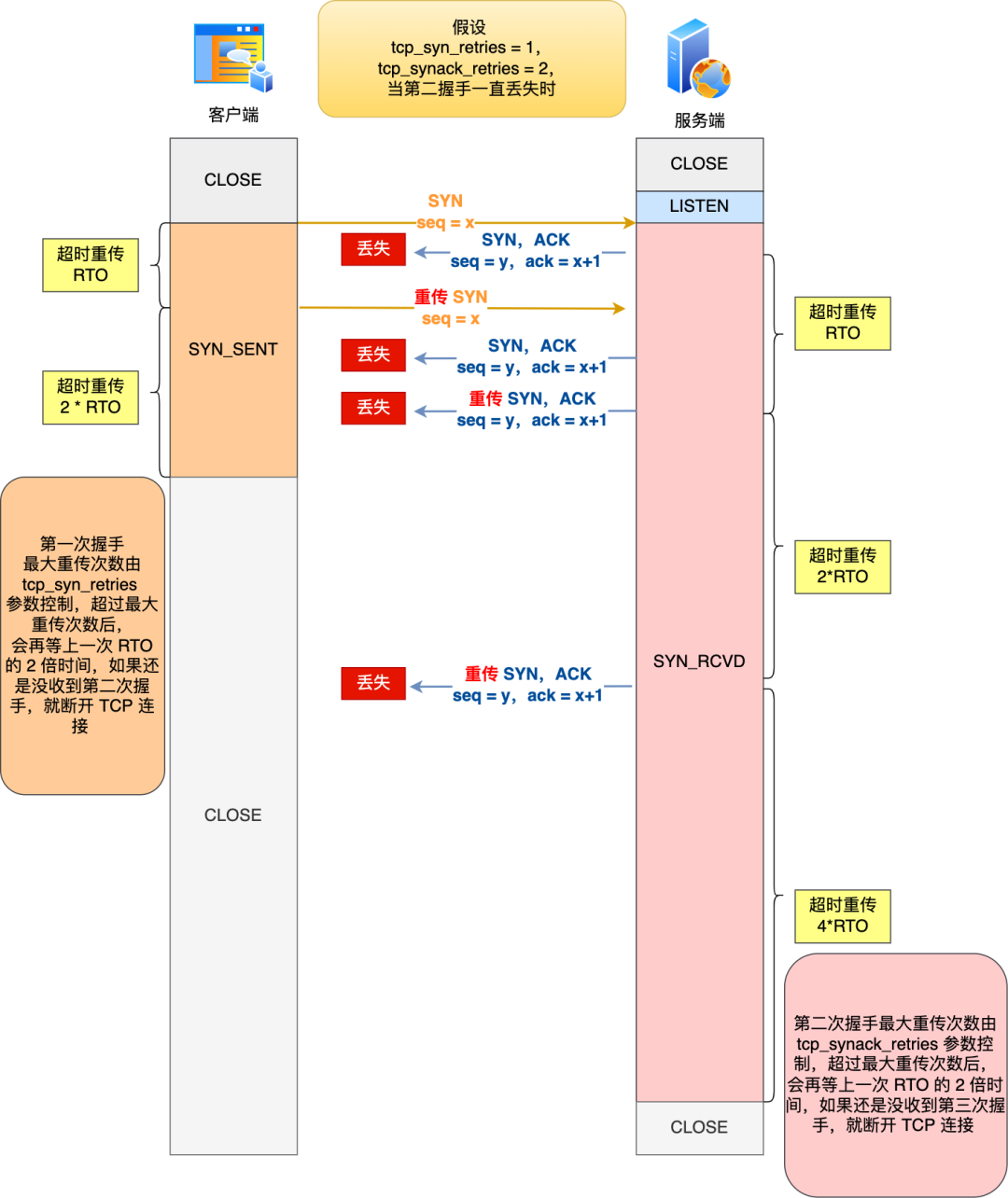
具体过程:
- 当客户端超时重传 1 次 SYN 报文后,由于 tcp_syn_retries 为 1,已达到最大重传次数,于是再等待一段时间(时间为上一次超时时间的 2 倍),如果还是没能收到服务端的第二次握手(SYN-ACK 报文),那么客户端就会断开连接。
- 当服务端超时重传 2 次 SYN-ACK 报文后,由于 tcp_synack_retries 为 2,已达到最大重传次数,于是再等待一段时间(时间为上一次超时时间的 2 倍),如果还是没能收到客户端的第三次握手(ACK 报文),那么服务端就会断开连接。
第三次握手丢失了,会发生什么?
客户端收到服务端的 SYN-ACK 报文后,就会给服务端回一个 ACK 报文,也就是第三次握手,此时客户端状态进入到 ESTABLISH 状态。
因为这个第三次握手的 ACK 是对第二次握手的 SYN 的确认报文,所以当第三次握手丢失了,如果服务端那一方迟迟收不到这个确认报文,就会触发超时重传机制,重传 SYN-ACK 报文,直到收到第三次握手,或者达到最大重传次数。
注意,ACK 报文是不会有重传的,当 ACK 丢失了,就由对方重传对应的报文。
举个例子,假设 tcp_synack_retries 参数值为 2,那么当第三次握手一直丢失时,发生的过程如下图:
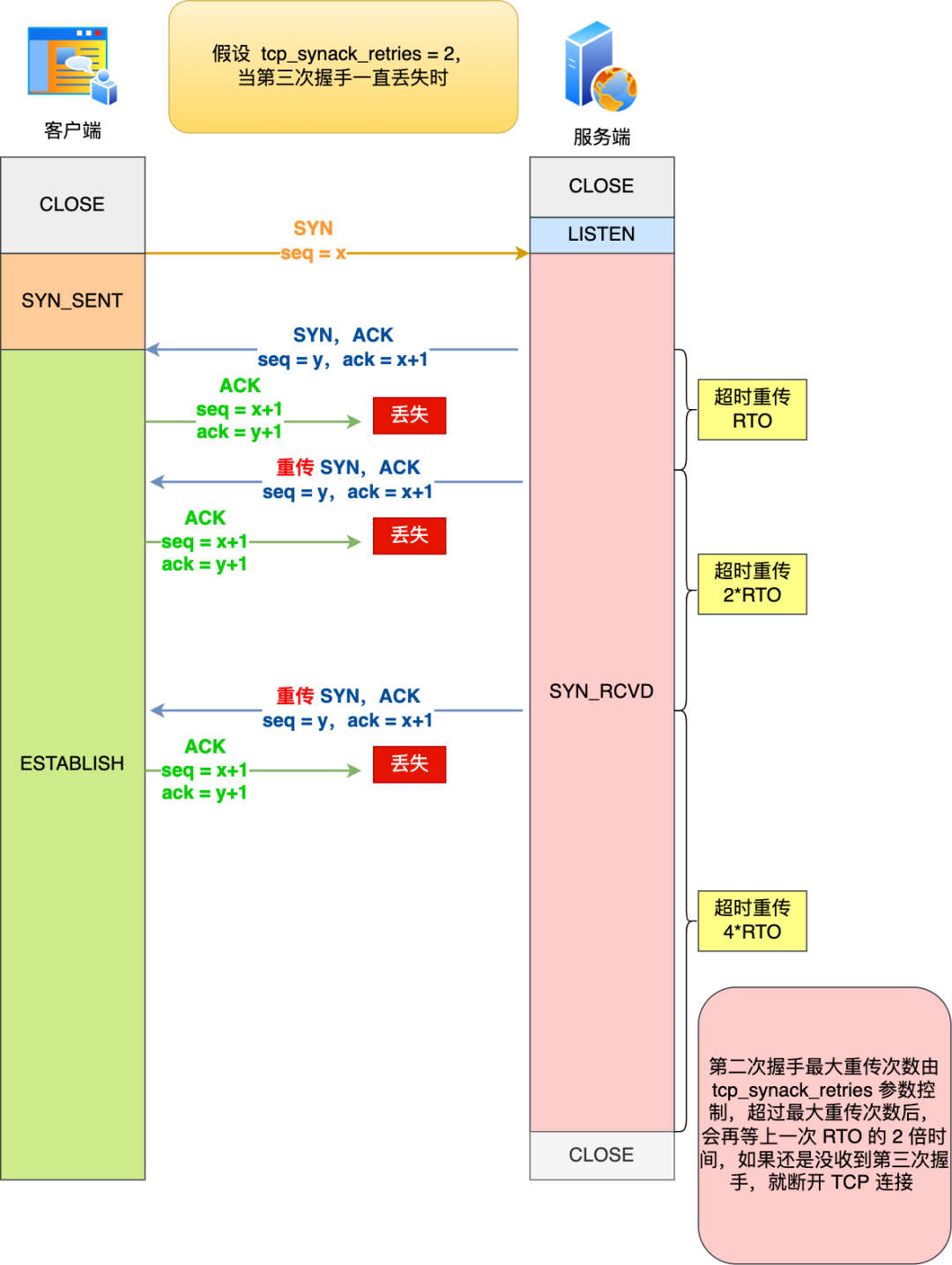
具体过程:
- 当服务端超时重传 2 次 SYN-ACK 报文后,由于 tcp_synack_retries 为 2,已达到最大重传次数,于是再等待一段时间(时间为上一次超时时间的 2 倍),如果还是没能收到客户端的第三次握手(ACK 报文),那么服务端就会断开连接。
TCP 四次挥手丢包情况
第一次挥手丢失了,会发生什么?
当客户端(主动关闭方)调用 close 函数后,就会向服务端发送 FIN 报文,试图与服务端断开连接,此时客户端的连接进入到 FIN_WAIT_1 状态。
正常情况下,如果能及时收到服务端(被动关闭方)的 ACK,则会很快变为 FIN_WAIT2状态。
如果第一次挥手丢失了,那么客户端迟迟收不到被动方的 ACK 的话,也就会触发超时重传机制,重传 FIN 报文,重发次数由 tcp_orphan_retries 参数控制。
当客户端重传 FIN 报文的次数超过 tcp_orphan_retries 后,就不再发送 FIN 报文,则会在等待一段时间(时间为上一次超时时间的 2 倍),如果还是没能收到第二次挥手,那么直接进入到 close 状态。
举个例子,假设 tcp_orphan_retries 参数值为 3,当第一次挥手一直丢失时,发生的过程如下图:
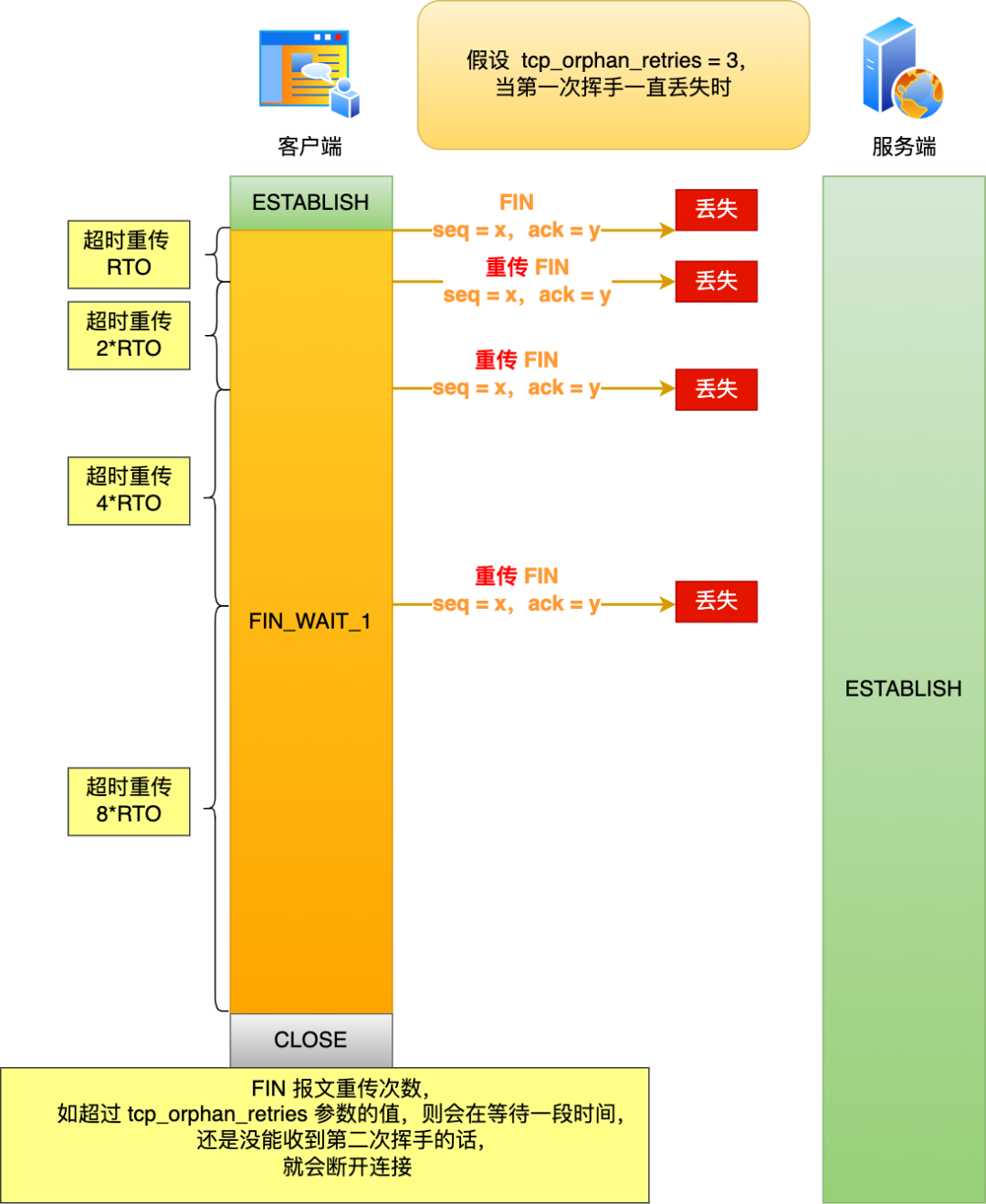
具体过程:
当客户端超时重传 3 次 FIN 报文后,由于 tcp_orphan_retries 为 3,已达到最大重传次数,于是再等待一段时间(时间为上一次超时时间的 2 倍),如果还是没能收到服务端的第二次挥手(ACK报文),那么客户端就会断开连接。
第二次挥手丢失了,会发生什么?
当服务端收到客户端的第一次挥手后,就会先回一个 ACK 确认报文,此时服务端的连接进入到 CLOSE_WAIT 状态。
在前面我们也提了,ACK 报文是不会重传的,所以如果服务端的第二次挥手丢失了,客户端就会触发超时重传机制,重传 FIN 报文,直到收到服务端的第二次挥手,或者达到最大的重传次数。
举个例子,假设 tcp_orphan_retries 参数值为 2,当第二次挥手一直丢失时,发生的过程如下图:
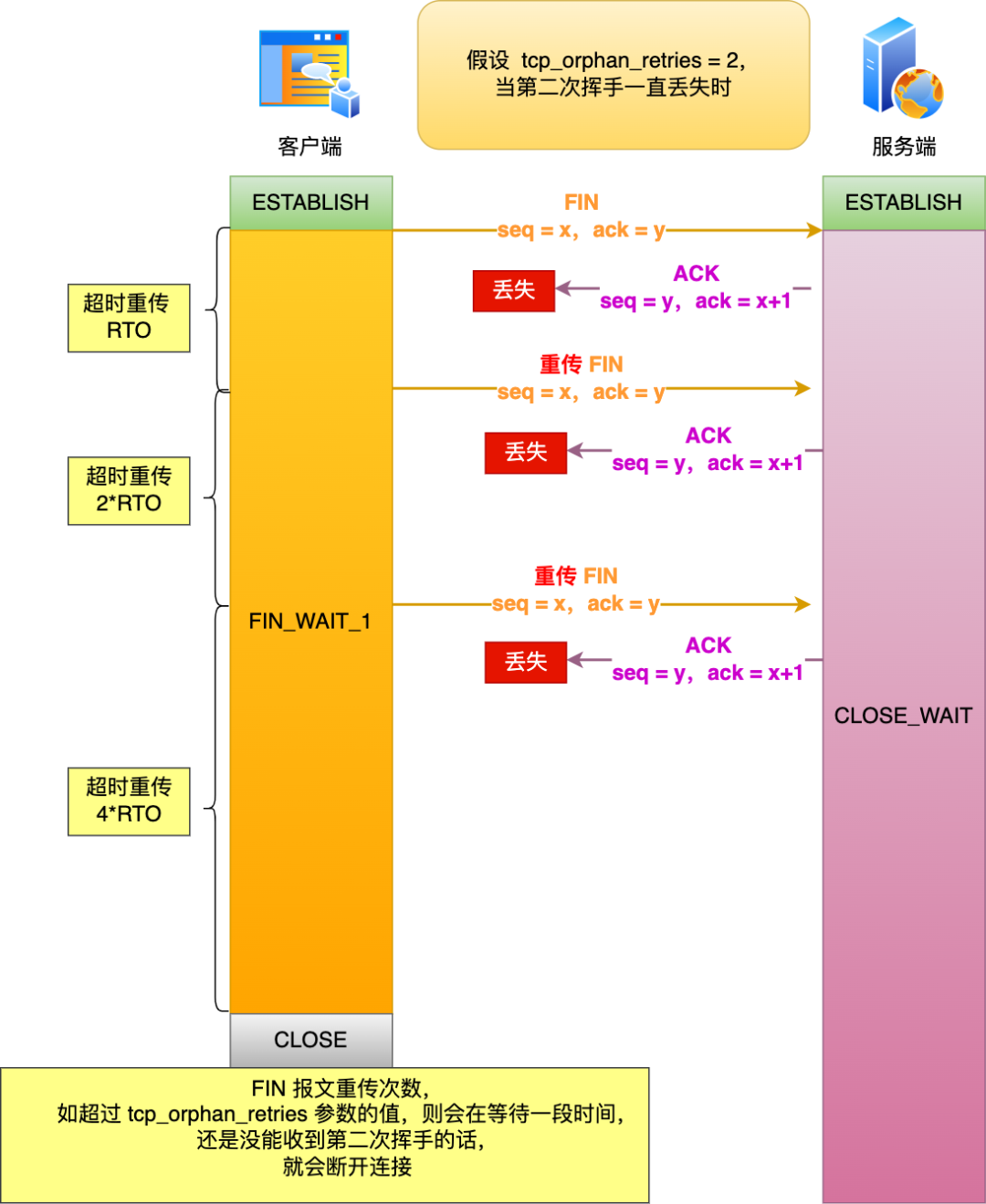
具体过程:
- 当客户端超时重传 2 次 FIN 报文后,由于 tcp_orphan_retries 为 2,已达到最大重传次数,于是再等待一段时间(时间为上一次超时时间的 2 倍),如果还是没能收到服务端的第二次挥手(ACK 报文),那么客户端就会断开连接。
这里提一下,当客户端收到第二次挥手,也就是收到服务端发送的 ACK 报文后,客户端就会处于 FIN_WAIT2 状态,在这个状态需要等服务端发送第三次挥手,也就是服务端的 FIN 报文。
对于 close 函数关闭的连接,由于无法再发送和接收数据,所以FIN_WAIT2 状态不可以持续太久,而 tcp_fin_timeout 控制了这个状态下连接的持续时长,默认值是 60 秒。
这意味着对于调用 close 关闭的连接,如果在 60 秒后还没有收到 FIN 报文,客户端(主动关闭方)的连接就会直接关闭,如下图:

但是注意,如果主动关闭方使用 shutdown 函数关闭连接,指定了只关闭发送方向,而接收方向并没有关闭,那么意味着主动关闭方还是可以接收数据的。
此时,如果主动关闭方一直没收到第三次挥手,那么主动关闭方的连接将会一直处于 FIN_WAIT2 状态(tcp_fin_timeout 无法控制 shutdown 关闭的连接)。如下图:
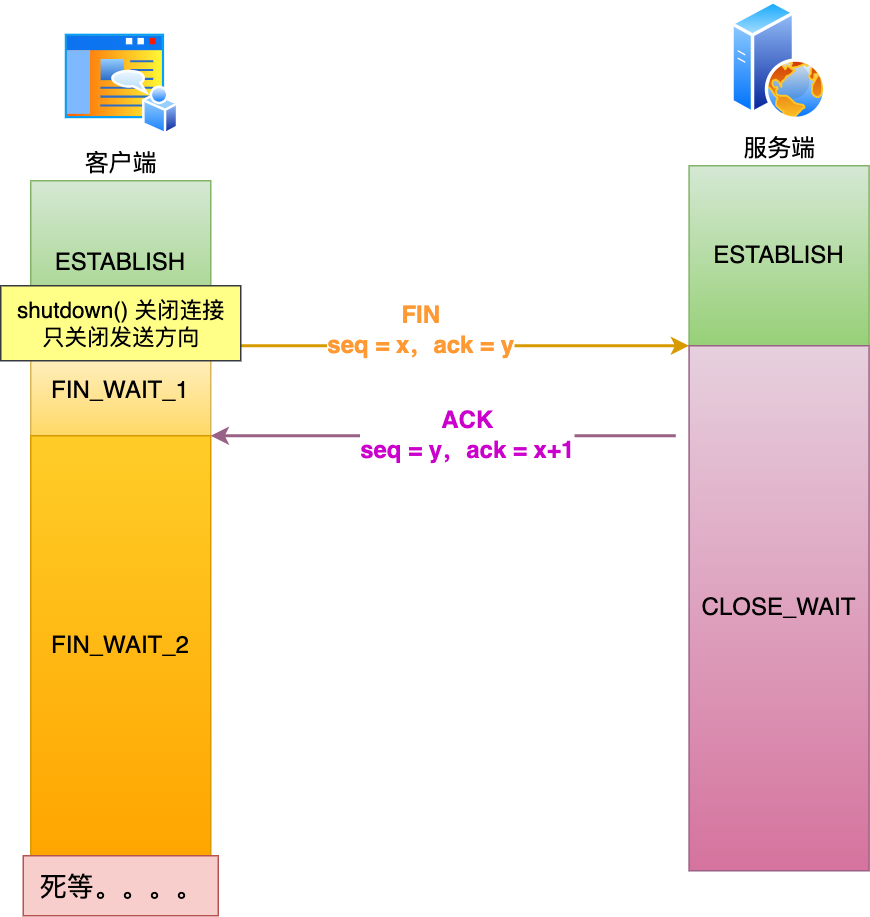
第三次挥手丢失了,会发生什么?
当服务端(被动关闭方)收到客户端(主动关闭方)的 FIN 报文后,内核会自动回复 ACK,同时连接处于 CLOSE_WAIT 状态,顾名思义,它表示等待应用进程调用 close 函数关闭连接。
此时,内核是没有权利替代进程关闭连接,必须由进程主动调用 close 函数来触发服务端发送 FIN 报文。
服务端处于 CLOSE_WAIT 状态时,调用了 close 函数,内核就会发出 FIN 报文,同时连接进入 LAST_ACK 状态,等待客户端返回 ACK 来确认连接关闭。
如果迟迟收不到这个 ACK,服务端就会重发 FIN 报文,重发次数仍然由 tcp_orphan_retries 参数控制,这与客户端重发 FIN 报文的重传次数控制方式是一样的。
举个例子,假设 tcp_orphan_retries = 3,当第三次挥手一直丢失时,发生的过程如下图:
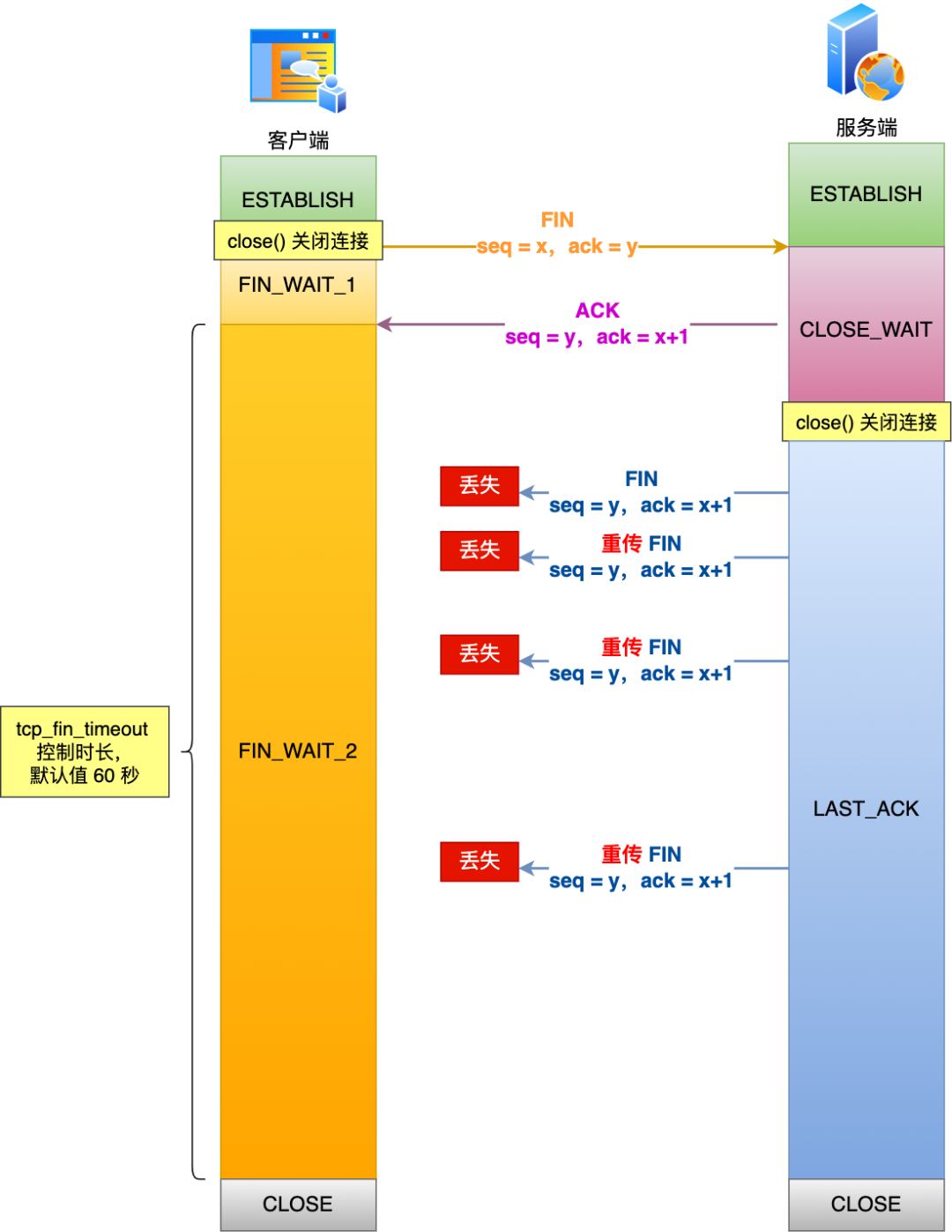
具体过程:
- 当服务端重传第三次挥手报文的次数达到了 3 次后,由于 tcp_orphan_retries 为 3,达到了重传最大次数,于是再等待一段时间(时间为上一次超时时间的 2 倍),如果还是没能收到客户端的第四次挥手(ACK报文),那么服务端就会断开连接。
- 客户端因为是通过 close 函数关闭连接的,处于 FIN_WAIT_2 状态是有时长限制的,如果 tcp_fin_timeout 时间内还是没能收到服务端的第三次挥手(FIN 报文),那么客户端就会断开连接。
第四次挥手丢失了,会发生什么?
当客户端收到服务端的第三次挥手的 FIN 报文后,就会回 ACK 报文,也就是第四次挥手,此时客户端连接进入 TIME_WAIT 状态。
在 Linux 系统,TIME_WAIT 状态会持续 2MSL 后才会进入关闭状态。
然后,服务端(被动关闭方)没有收到 ACK 报文前,还是处于 LAST_ACK 状态。
如果第四次挥手的 ACK 报文没有到达服务端,服务端就会重发 FIN 报文,重发次数仍然由前面介绍过的 tcp_orphan_retries 参数控制。
举个例子,假设 tcp_orphan_retries 为 2,当第四次挥手一直丢失时,发生的过程如下:
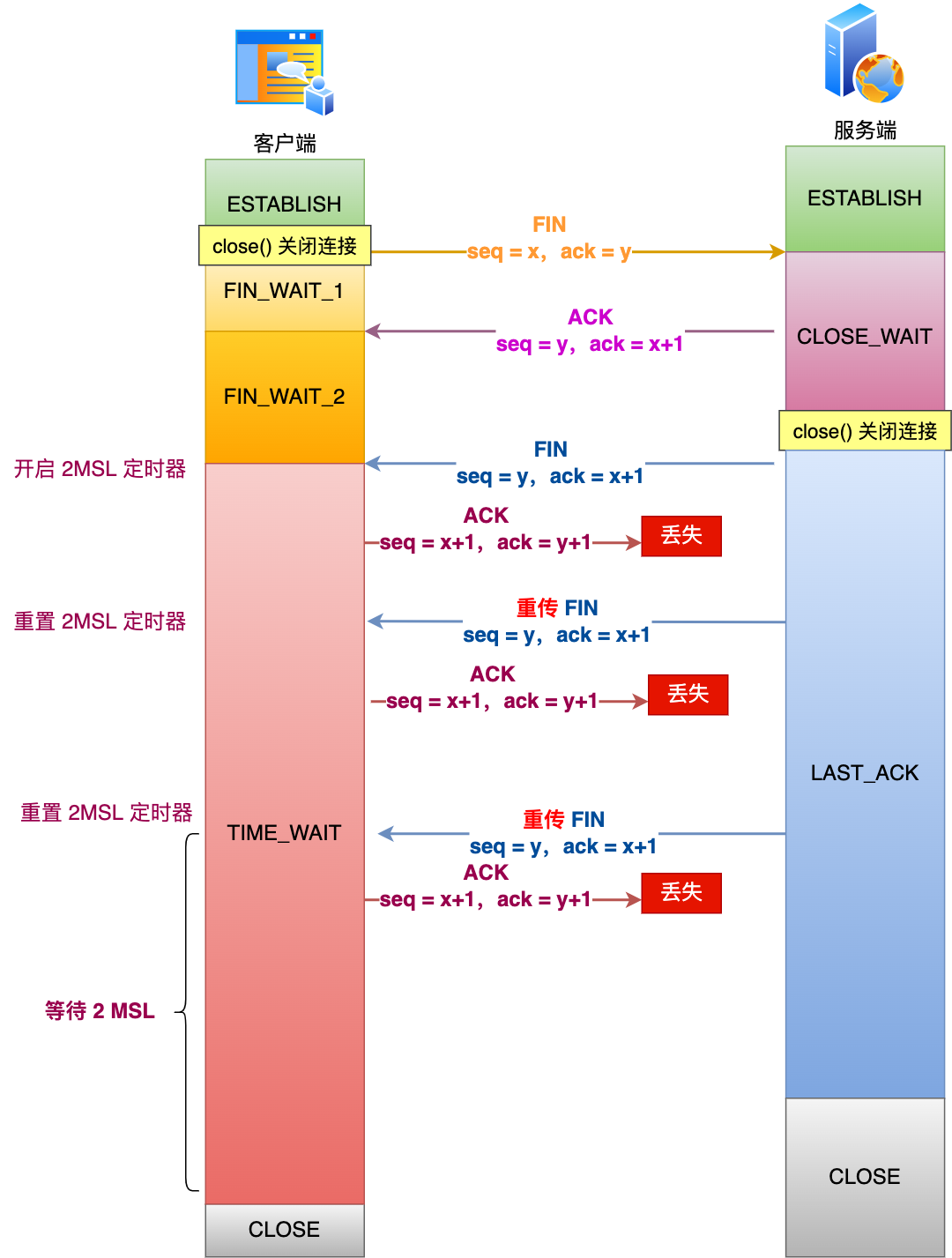
具体过程:
- 当服务端重传第三次挥手报文达到 2 时,由于 tcp_orphan_retries 为 2, 达到了最大重传次数,于是再等待一段时间(时间为上一次超时时间的 2 倍),如果还是没能收到客户端的第四次挥手(ACK 报文),那么服务端就会断开连接。
- 客户端在收到第三次挥手后,就会进入 TIME_WAIT 状态,开启时长为 2MSL 的定时器,如果途中再次收到第三次挥手(FIN 报文)后,就会重置定时器,当等待 2MSL 时长后,客户端就会断开连接。